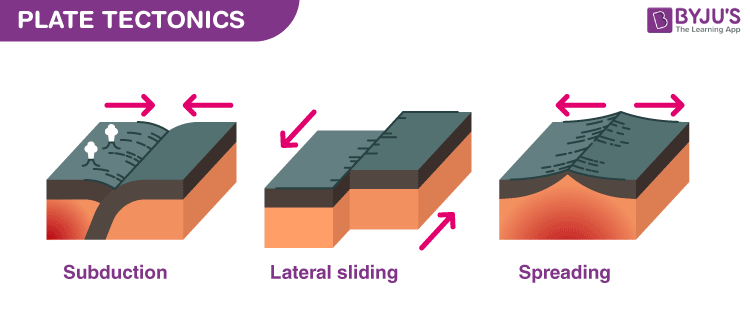Briefly Describe the Theory of Plate Tectonics
Slab pull refers to older slabs of oceanic lithosphere. Ridge push is a gravity-driven mechanism that results from the elevated position of the oceanic ridge which causes slabs of.

Brief History Of The Plate Tectonics Theory Earth Observatory Of Singapore
This happens above subjecting plates at.

. Tectonic plates jam against another forcing the crust upwards along with deep rock. Divergent Plate Boundaries 2. What is the theory of plate tectonics.
That are more dense sink into the asthenosphere and pull the trailing plate along. Plates can include oceanic andor continental lithosphere. These tectonic plates move very gradually.
O the outer layer of. The Movement of these plates is responsible for formation of various landforms on earth. The theory which solidified in the 1960s transformed the earth sciences by explaining many phenomena including mountain building events volcanoes and earthquakes.
Plates move towards one another and one usually subjected except with continent-continent they smash and create a mountain. Can be slow An alternative. In plate tectonics Earths outermost layer or lithosphere.
Solutions for Chapter RC6 Problem 1RQ. How does Wegeners theory differ from the modern theory of plate tectonics. Happens above subducting plates at convergent plate boundaries.
Stripes of magnetic material in the seafloor provide strong evidence for tectonic theory. It started as a hypothesis and had to be proven with hard evidence before being completely accepted by the scientific community. Continental Drift Animation Start 000 end at 355 Read Read Historical.
Supermanreturns 4 years ago. The earths lithosphere is composed of seven or eight major plates and many minor plates. Plate tectonics is the theory that Earths outer shell is divided into several plates that glide over the mantle the rocky inner layer above the core.
Another cause is salt that bonds with water molecules causes a chemical reaction for snow to melt on the crust. Describe the three types of tectonic plate boundaries. View 1-18 plate tectonics assignmentpdf from GLY 101 at Aiken Technical College.
What evidence supported his ideas. According to the theory of plate tectonics large pieces of Earths lithosphere called plates move slowly over Earths surface driven by convection currents in the mantle. In other words the Earths solid outer crust the lithosphere is separated into plates that move over the asthenosphere the molten upper portion of the mantle.
There are around 13 tectonic plates that float around on the asthenosphere the plastic-like layer of Earths mantle. Get solutions Get solutions Get. It states that Lithosphere is not continuous but broken into plates which float on asthenosphere.
Tectonic plates can slowly separate the crust which could cause a continent to be detached from its parent body of land. About 3 centimeters per year. Briefly describe the major differences between the evolution of the Appalachian Mountains and the North American Cordillera.
The theory of plate tectonics like every scientific theory resulted from centuries of observations and compilation of many scientists works. A theory where Earths outer shell and plates interacts in various ways producing earthquakes volcanoes mins and crust itself. Plate Tectonics assignment 1.
The Earths lithosphere is comprise of a number of large tectonic plates which have been slowly moving. Each type of plate boundary generates distinct geologic. Plate tectonics is the theory that Earths crust and upper mantle called the lithosphere is broken up into sections called tectonic plates.
This animation starts 750 million years ago and ends with the present day. Oceanic and continental plates come together spread apart and interact at boundaries all over the planet. Plate interactions help cause earthquakes volcanoes and mountain building.
The basic theory of plate tectonics is that along seafloor spreading zones the. Be able to draw them. This preview shows page 5 - 6 out of 6 pages.
Briefly describe Alfred Wegeners theory of continental drift. An Introduction Watch Continental Drift Animation on the UCMP Berkeley website. The concept of plate tectonics was formulated.
This strong outer layer is called the lithosphere. According to the theory of Plate Tectonics. Plate tectonics is a scientific theory that explains how major landforms are created as a result of Earths subterranean movements.
Plates move away from one another. List and Describe the Evidence for the Plate Tectonics Theory The Theory of Plate Tectonics. In your own words briefly explain the theory of plate tectonics.
Briefly explain the theory of plate tectonics. Transform plates slide next to each other. Nonetheless we consider Alfred Wegener a.
The Plate Tectonic theory is based on sea floor spreading theory and Paleo -Magnetism. Plate Tectonics and Continental Drift Watch Watch Plate Tectonics. Three mechanisms that have proposed to explain plate motion include slab pull ridge push and whole-mantle convection.
Theory of plate tectonics explain the existence of this mountain belt in the interior of an expansive landmass. The theory of plate tectonics states that the Earths solid outer crust the lithosphere is separated into plates that move over the asthenosphere the molten upper portion of the mantle. Plate tectonics theory dealing with the dynamics of Earths outer shellthe lithospherethat revolutionized Earth sciences by providing a uniform context for understanding mountain-building processes volcanoes and earthquakes as well as the evolution of Earths surface and reconstructing its past continents and oceans.
Theory of plate tectonics explain the existence of. Tectonic plates can crash together pull apart burrow under another slide alongside each other jam together causing part of Earths crust to move and quake. Brief history of the plate tectonics theory.
The plates act like a hard and rigid shell compared to Earths mantle.
Plate Tectonic Theory The British Geographer

Plate Tectonics Tectonics Plate Movements Plate Tectonic Theory

No comments for "Briefly Describe the Theory of Plate Tectonics"
Post a Comment